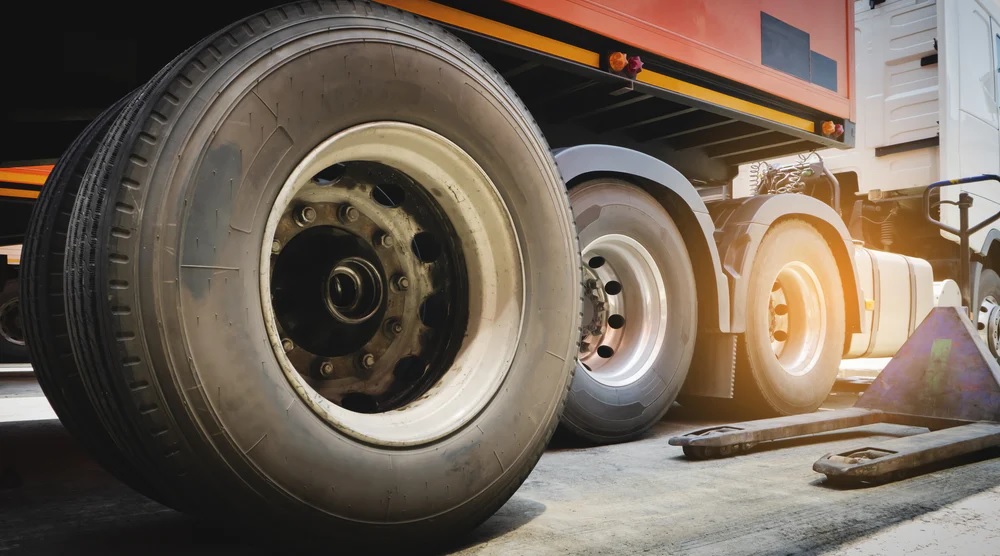Having trouble keeping up with tire service, avoiding roadside events, and keeping costs down? A tire management solution might be the way to go.
A total tire management strategy should be part of every fleet’s operation, noted Brandon Gray, operational marketing manager, B2B Services, at Michelin North America. “Fleets with active tire management practices report fewer tire-related roadside service calls, more successful retread programs and overall lower cost-per-mile for tires,” he said. “A well-managed program can save a fleet in many ways including fewer violations, less downtime, and lower unplanned expenses.”
Gray went on to list elements that should be part of a fleet’s tire strategy. Those include equipment inventory, tire selection, tracking, preventive maintenance, expected casing life, pressure and tread data, loads carried, miles achieved from tires and retreads, inspection frequency, removal timeline, casing management, scrap tire analysis, end-of-life inspection, retread guidelines, automatic inflation devices, and a budget review.
Tom Fanning, Continental’s head of truck tires for the U.S. market, said fleets can benefit from periodically reviewing their tire data. “It can help them identify potential improvements that could reduce their tire program costs, such as changing air pressure management or truck alignment practices,” he stated. “They can find causes of retread casing rejection which could potentially be prevented. The bottom line benefit to the fleet should be measured in increased uptime and reduced tire program costs.
“An effective tire partner can help fleets identify changes that can support those goals,” Fanning continued. “Fleets should look for a tire manufacturer who can partner with them to deliver the lowest overall cost. Tires are just one factor that impacts a fleet’s productivity, uptime, costs and safety, but tires can make important contributions in each of those areas.”
Understanding the state of these crucial components can also help fleet maintenance staffs stay ahead of any potential problems.
“Tire management programs are all about helping fleets protect their investment,” said Austin Crayne, business development lead at Goodyear North America Commercial. “By knowing the condition of tires, fleets can see benefits to their overall bottom line. Tire management programs also help fleets identify issues that need to be resolved so work can be done on a tire before it becomes an issue.
“We have seen many fleets drive costs down by using tire management technologies,” Crayne added.” Some fleets have reported up to an 85% reduction in tire-related breakdowns, while others claim a 2-3% increase in fuel efficiency. In many cases, fleets have said these programs pay for themselves.”
Kyle Chen, marketing manager at Bridgestone Americas Tire Operations, U.S. and Canada, related how the company utilizes a customizable, multi-dimensional solution to help fleets manage tire assets. “The program begins before a tire is even purchased and continues to track how it’s used and maintained, maximizing the number of service lives through retreading,” he explained. “The approach is augmented by the thorough tracking of tire inventories.
“In collaboration with field teams and our commercial dealer network, we work closely with fleets to establish customized tire programs focused on best practices for tire selection and maintenance,” Chen added. “Technologies such as Toolbox and Intellitire facilitate the monitoring and gathering of real-time data, and compliance and effectiveness of the tire program is audited by regular fleet inspections.”
Gray cited several Michelin solutions to help fleets. MICHELIN Tire Care is a predictive program that helps anticipate future tire needs. By partnering with service providers in the MICHELIN Commercial Service Network, tires are inspected on site for signs of low pressure, irregular wear and uneven tread depths. The solution then provides customizable reporting to track immediate needs and forecast future requirements.
Michelin also offers the Maestro Fleet Order platform that replaces manual and paper-driven processes with a digital system for ordering tires and retreads. The solution provides fleets with access to real-time inventory and order status tracking.
The Conti360° Fleet Services portal, Fanning related, ensures fleets can access data from full case history reporting on tire breakdowns, including photos, to inspection reports on mismatched dual tires, damage, irregular tread wear, air pressure and tread depth. The data, which is generated by the company’s ContiTrack2 digital tire tracking tool, also includes projected mileage remaining on tires. Available as well is information on retreads in production and casing refusal statistics.
Goodyear’s Crayne said tire management includes using a variety of technologies. Active monitoring technologies, which provide information about tires back to a fleet, most often have telematics that interact with the vehicle, such as the company’s TPMS Plus connected tire pressure monitoring system.
At the same time, fleets can use Goodyear’s Tire Optix digital inspection system to guide technicians through inspection processes and access reports instantly, as well as build a historical inspection database. Automated inspection technologies, such as the CheckPoint system placed at the entrance to facilities, pull information on air pressure, tread and load off vehicles and share that data through email alerts or direct integration into a fleet’s maintenance system.
“Locally, and at the fleet enterprise level, actionable intelligence is a result of fleet tire asset tracking,” Chen said. “Ultimately, savings for fleets grow exponentially when they implement comprehensive tire management programs.”
By Seth Skydel
Source: https://www.fleetmaintenance.com






